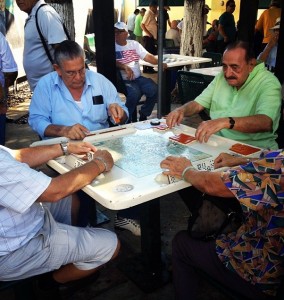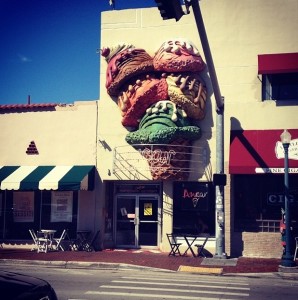Posted November 11, 2013
By MIKAYLA VIELOT
MIAMI — With a slight bounce in his step, salt and pepper curly hair and shoe shining box in one hand, Cairo Gutierrez strolls down “Calle Ocho” (Spanish for Eighth Street) looking for business.
Car dealerships, hair salons, restaurants, cigar shops and boutiques line busy Eighth Street in Miami’s Little Havana, home to many Cubans.
The Nicaraguan native has lived in Miami for about 20 years and has been a shoe shiner since the early 1990s. Gutierrez ventures to Little Havana three or four times a week looking for customers.
“I have a client at the dealership and know a lot of business people come to the area for a quick bite to eat,” he said as he sits on a shining box.
The rapid concentration of Cubans in the 1960s gave the neighborhood its name. Just west of downtown Miami, Little Havana has a reputation of cultural street life. Music, dancing, food, games and laughter fill the streets with vibrant energy.
Gutierrez continued walking down Calle Ocho towards SW 16th Avenue, the heart of Little Havana. Along the way, he pointed out men laughing and looking at photo albums outside of liquor stores and elderly couples dancing in the streets to tunes of their native country.
“This is a cheap residential area; one of the poorest towns in Miami,” he said. “But some of the most hardworking people live here. Painters, construction workers, carpenters all live here with their families. They’re good people.”
But Little Havana is not just home for Cubans. Many South Americans and Central Americans relocated here. The familiarity among cultures is very present. Gutierrez smiled and made conversation with nearly everyone he passed.
“These people are like family because they also speak Spanish. It doesn’t matter if we’re friends or not, we’ll find something to talk about.”
Nancy Torres, a middle-aged Puerto Rican woman has lived in the area for more than 30 years. She spends her days doing interior design work and painting but takes some time out to visit with friends at their stores.
“This area has changed so much but truly for the better. Buildings are being renovated and more diverse people are moving in,” Torres said. “There is much more of a cultural display.”
At the corner of SW Eighth Avenue and SW 14th Street, two men sat outside of music store playing the drums. There was no jar collecting money; they were doing it solely for entertainment purposes. Everyone from the store owner to customers to Gutierrez stop for a quick dance. Onlookers clap and sway to the beat.
“This is why they have the tourist buses,” Gutierrez said, pointing at a passing bus. “People need to see the culture and richness of Little Havana. We are more than just a poor neighborhood.”
Just a few steps away, the shuffle of dominoes can be heard. Retirees and tourists pile into Maximo Gomez Park. Definitely a tourist attraction, “Domino Park” is a huge staple in the community. The park provides a place for older men to socialize with one another. Even with drugs flowing in and out of Miami in the 1980s, the park provided a recreational activity for those who live in the area.
Across the street is another gem, Azucar Ice Cream. The parlor turns ice cream into a cultural experience featuring flavors such as Abuela Maria, Café con leche, Domino, Platano Maduro, Cuatro Leches and guava.
Robert Coseano, a student at Florida International University, has worked at the shop since it opened two years ago. Throughout the day, buses of tourists unload and cross the street making a direct line for Azucar. Cameras in tow, he explains the different flavors and passes out samples.
“At this time of year, most tourists are European, South Americans and Asians and they come in very interested with Cuban culture,” Caseano said. “There are so many attractions on this street alone. This is where you come to see Hispanic Culture and experience the real Miami. Not the fantasy of Miami that you get on South Beach.”
“This is how most people in Miami grew up. The food is one of the best parts. The rice and beans, chicken and steak were all huge parts of our upbringing. It’s a great time without spending much money,” he continued.
When northerners fly South this winter, it would be wise to visit Little Havana and save money instead of blowing it all at fancy restaurants on the beach. Little Havana has all of the “flavor” that locals appreciate about Miami.
If You Go
Azucar
- 1503 SW 8th St., Miami, Fla. 33135
- Must try the Abuela Maria, Café con Leche, Caramel Flan, Guava and Mango.
El Credito Cigar Factory
- 1100 SW 8th St., Miami, Fla. 33135
- Experts roll cigars right in front of you.
Maximo Gomez Park
- 801 SW 15th Ave., Miami, Fla. 33135
- Locals and tourists congregate to play dominoes in the park.


